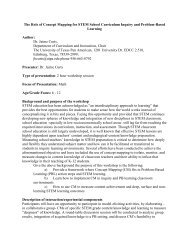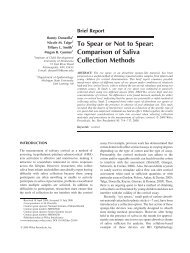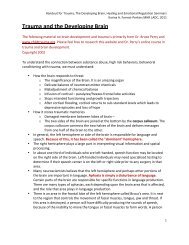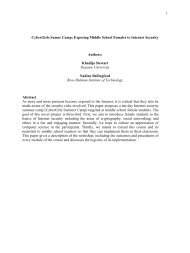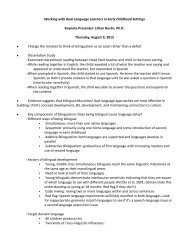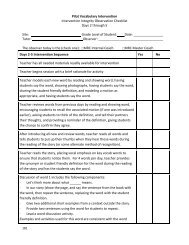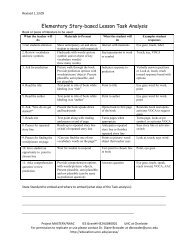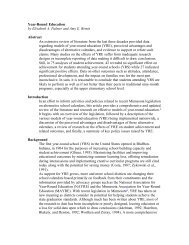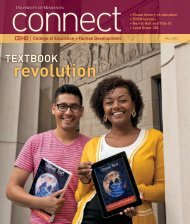Introduction to Positive Ways of Intervening with Challenging Behavior
Introduction to Positive Ways of Intervening with Challenging Behavior
Introduction to Positive Ways of Intervening with Challenging Behavior
You also want an ePaper? Increase the reach of your titles
YUMPU automatically turns print PDFs into web optimized ePapers that Google loves.
Peer Tu<strong>to</strong>ring...<br />
a proactive intervention for the classroom<br />
This Intervention Tip Sheet has been developed <strong>to</strong> assist teachers and parents in providing the best possible<br />
educational opportunities <strong>to</strong> students <strong>with</strong> emotional and behavioral disorders. This Tip Sheet was published by<br />
the Institute on Community Integration, College <strong>of</strong> Education, University <strong>of</strong> Minnesota, Minneapolis and was<br />
authored by Kareen Smith <strong>of</strong> the Institute.<br />
<strong>Introduction</strong><br />
Peer tu<strong>to</strong>ring is an organized learning experience in which one student serves as the teacher or tu<strong>to</strong>r, and one is<br />
the learner or tutee. It gives students an opportunity <strong>to</strong> use their knowledge in a meaningful, social experience<br />
(Conrad, 1974). Tu<strong>to</strong>rs reinforce their own learning by reviewing and reformulating their knowledge. Tutees gain<br />
one-on-one attention. Both tu<strong>to</strong>rs and tutees gain self-confidence (Howard et al., 1986), the tu<strong>to</strong>r by seeing selfcompetence<br />
in his or her ability <strong>to</strong> help someone and the tutee by receiving positive reinforcement from peers.<br />
Who should be a tu<strong>to</strong>r?<br />
All students <strong>with</strong> some level <strong>of</strong> responsibility should be given the opportunity <strong>to</strong> be tu<strong>to</strong>rs. Research has shown<br />
that the achievement level <strong>of</strong> the tu<strong>to</strong>r does not matter in terms <strong>of</strong> tutee gains (Conrad, 1974).<br />
How do I train tu<strong>to</strong>rs?<br />
In order <strong>to</strong> have a successful peer-tu<strong>to</strong>ring program, tu<strong>to</strong>rs do need <strong>to</strong> be trained. Basing a tu<strong>to</strong>r-training program<br />
on the following method has been shown <strong>to</strong> produce effective peer-tu<strong>to</strong>rs:<br />
<strong>Positive</strong> verbal feedback: Teach your tu<strong>to</strong>rs the importance <strong>of</strong> positive verbal feedback. Prompt students <strong>to</strong> come<br />
up <strong>with</strong> a list <strong>of</strong> standard statements which they feel may be positively reinforcing. They also need <strong>to</strong> be taught<br />
how much positive feedback <strong>to</strong> give. Giving feedback after each and every response can take <strong>to</strong>o much time and<br />
diminish its effect. Teach tu<strong>to</strong>rs <strong>to</strong> give genuine praise after every third or fourth correct response and after<br />
particularly difficult problems. Make sure <strong>to</strong> have them practice.<br />
Corrective feedback: Teach your tu<strong>to</strong>rs how <strong>to</strong> respond when an incorrect answer is given. When an incorrect<br />
answer is given, the tu<strong>to</strong>r should promptly give and explain the correct answer <strong>with</strong>out being critical <strong>of</strong> the tutee,<br />
and then give the tutee an opportunity <strong>to</strong> repeat the correct answer.<br />
Modeling by you, the teacher: Model these behaviors for the tu<strong>to</strong>rs-in-training. Give correct and incorrect<br />
examples <strong>of</strong> how <strong>to</strong> give positive and corrective feedback. This is a good opportunity for the tu<strong>to</strong>rs <strong>to</strong> ask any<br />
questions they may have.<br />
Role-playing between teacher and tu<strong>to</strong>rs: Role- play the tu<strong>to</strong>ring process <strong>with</strong> each tu<strong>to</strong>r, alternately playing<br />
the role <strong>of</strong> both tu<strong>to</strong>r and tutee. This is a good time for those observing <strong>to</strong> practice using their positive and<br />
corrective feedback knowledge, <strong>to</strong> give suggestions, and <strong>to</strong> share any ideas for improvement.<br />
Role-playing between students: This is identical <strong>to</strong> the role-playing between teacher and tu<strong>to</strong>rs except that, in<br />
this step, the teacher observes and coaches tu<strong>to</strong>rs.<br />
How do I initiate peer-tu<strong>to</strong>ring?<br />
Tu<strong>to</strong>r-training, including those components listed above, should take place over several sessions so that the tu<strong>to</strong>rs<br />
have plenty <strong>of</strong> opportunity <strong>to</strong> practice and begin <strong>to</strong> feel comfortable. It will probably also be necessary <strong>to</strong> provide<br />
assistance during the onset <strong>of</strong> tu<strong>to</strong>ring.




